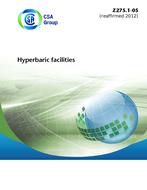CSA Z275.1-05 (R2012)
Click here to purchase
Preface
This is the fourth edition of CSA Z275.1, Hyperbaric facilities. It supersedes the previous editions published in 1993, 1982, and 1974.
1 Scope
1.1 General
1.1.1This Standard applies to hyperbaric chambers that have as their primary function the subjection of humans to pressure environments exceeding 1 atmosphere absolute, such as those required in diving operations, work under compressed-air conditions, medical treatment, training, and research.
1.1.2This Standard establishes minimum requirements for the operation, use, design, construction, maintenance, and testing of all hyperbaric chambers.
1.2 Classification of manned chambers
1.2.1 GeneralThis Standard addresses the following classes of manual chambers:(a) Class A – multiple occupancy;(b) Class B – single-occupancy and evacuation chambers; and(c) Class C – submersible compression chamber.
1.2.2Class A – Multiple occupancy
1.2.2.1 StationaryA multiple-occupancy hyperbaric chamber permanently installed in a vessel, platform, or shore-based facility and fixed to a permanent foundation, i.e., the vessel, platform, or building in which it is housed, is known as a stationary chamber.
1.2.2.2 TransportableA transportable chamber is a multiple-occupancy hyperbaric chamber that can be moved to a diving or caisson site to support on-site operations.
1.2.3Class B – Single-occupancy and evacuation chambers
1.2.3.1 EvacuationA single- or multiple-occupancy hyperbaric chamber that has as its primary function the emergency transportation under pressure of an individual at risk of, or suffering from, a pressure-related ailment is known as an evacuation chamber. This sub-class also includes hyperbaric rescue craft.
1.2.3.2 MonoplaceA monoplace chamber is a hyperbaric chamber normally intended for the treatment of one person and capable of oxygen or air pressurization to a depth not exceeding 20 m (66 ft) for the provision of hyperbaric oxygen therapy, normally for clinical applications only.
1.2.4Class C – Submersible compression chamber (SCC) A hyperbaric chamber that is capable of transporting personnel, at elevated pressures, from the surface to an underwater site and vice versa is known as a submersible compression chamber (SCC).
1.3 HazardsIn the design, construction, operation, and maintenance of hyperbaric facilities, safety begins with a recognition of the special hazards associated with hyperbaric facilities. (See Annexes A, B, and C for a description of potential hazards.) Consideration and control of these hazards is the basis for criteria in this Standard.
1.4 TerminologyIn CSA Standards, “shall” is used to express a requirement, i.e., a provision that the user is obliged to satisfy in order to comply with the standard; “should” is used to express a recommendation or that which is advised but not required; “may” is used to express an option or that which is permissible within the limits of the standard; and “can” is used to express possibility or capability.
Notes accompanying clauses do not include requirements or alternative requirements; the purpose of a note accompanying a clause is to separate from the text explanatory or informative material.
Notes to tables and figures are considered part of the table or figure and may be written as requirements. Annexes are designated normative (mandatory) or informative (non-mandatory) to define their application.
1.5 Units of measurementThe values given in SI (metric) units are the standard. The values given in parentheses are for information only.
Product Details
- Published:
- 08/26/2005
- Number of Pages:
- 72
- File Size:
- 1 file , 870 KB
- Product Code(s):
- 2418041, 2417693, 2417693
